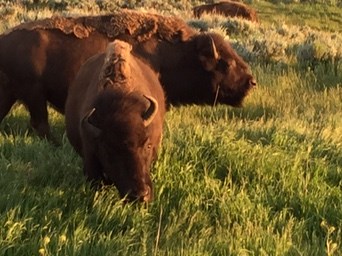Last updated: November 6, 2017
Article
Bison Bellows: Bison East of The Mississippi

NPS Photo/A. Hardy
Bison east of the Mississippi are mostly gone from American memory. Yet they were once widespread and regionally abundant, leaving lasting impressions on the eastern landscape. There are towns named "Buffalo" in eight eastern states. There are "Buffalo Rivers" or "Buffalo Creeks" in at least seven states and "Buffalo Mountains" in four. Several towns owe their names to ancient buffalo mineral licks. These include French Lick, Indiana and Stamping Grounds, Kentucky.
Bison occurred from New York to Florida and from the Mississippi River to the tide-water lands of the east coast. Locally, Native Americans, and later during the 17th and 18th centuries, Europeans depended upon bison for meat, shelter, clothing and other products. Well worn bison trails, called "traces" were commonly used for human travel, as they extended for many miles. Many became routes for today's roads and railroads.
Beginning in the 1670's, Spanish journals record bison in Florida, especially in the panhandle, and in neighboring states. While these bison were commonly hunted by Native Americans and Spaniards, and bison robes were common possessions, fewer than ten bison were recorded as harvested in a day. Bison herds seem to have consisted of dozens, perhaps rarely a few hundred, animals.
The Illinois tall-grass prairies supported bison herds of at least hundreds of animals. This habitat extended across Indiana into Ohio and western Kentucky. In 1769, Daniel Boone relates seeing thousands of buffalo on the western Kentucky bluegrass. Such numbers occurred primarily at mineral licks that attracted bison from all directions, as evidenced by numerous radiating traces. Also in 1769, George Washington killed bison in the Kanawha Valley of West Virginia. At this time bison were rather plentiful in the Ohio River Valley. Soon, bison were part of a commercial trade, mostly of hides, along the Ohio River and its major tributaries, including the Wabash, Kentucky, Tennessee and Cumberland Rivers. Downstream, New Orleans became a shipping point for pelts to Europe and for salted meat to the West Indies to feed enslaved workers.
Bison appear to have been less abundant east of the Appalachian Mountains and rare within the forested mountains. An Englishman first reported bison near the Potomac River in 1612.
Likely, Native Americans were limiting bison abundance and distribution in the East before 1500; whereas bison numbers rebounded during the 1600s when Native American tribes were decimated by European diseases that proceeded Euro-Americans inland.
Extirpation of bison began in east Virginia tidelands in 1730, and proceeded westward. By the 1770s bison were gone from most or all of North and South Carolina, Alabama and Florida. Other terminal dates for bison are given as: Georgia in the early 1800s; Pennsylvania, 1801; Louisiana, 1803; Illinois and Ohio, 1808; Tennessee, 1823; West Virginia, 1825; Indiana, 1830; and Wisconsin, 1832.
There probably were about 2-4 million bison east of the Mississippi River. Little of the most important bison habitats remain east of the Mississippi. Tall-grass prairies and canebrakes are now rare. These lands are some of the most subdivided, intensively used and productive agricultural lands in the nation. Opportunities for restoration of wild plains bison east of the Mississippi are slim, if they exist at all.
Extracted with permission from: Bailey, J. A. 2014. American Plains Bison: Rewilding an Icon. Farcountry Press, Montana. Bailey relied largely on Belue, T. F. 1996. The Long Hunt: Death of the Buffalo East of the Mississippi, Stackpole Books, Pennsylvania.
